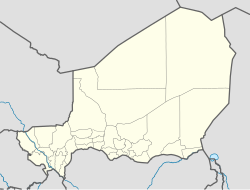Agades
|
Agadez اغادیز |
|
|---|---|

View of Agadez, from a minaret
|
|
| Coordinates: 16°58′0″N 7°59′0″E / 16.96667°N 7.98333°ECoordinates: 16°58′0″N 7°59′0″E / 16.96667°N 7.98333°E | |
| Country |
|
| Region | Agadez Region |
| Department | Tchirozerine Department |
| Commune | Agadez |
| Sultanate | 1449 CE |
| Government | |
| • Mayor | Rhissa Feltou |
| Elevation | 520 m (1,710 ft) |
| Population (2012 census) | |
| • Total | 118,244 |
| UNESCO World Heritage Site | |
| Official name | Historic Centre of Agadez |
| Criteria | Cultural: (ii), (iii) |
| Reference | 1268 |
| Inscription | 2013 (37th Session) |
|
[]
|
|
Agadez, formerly spelled Agades, is the largest city in central Niger, with a population of 118,244 (2012 census). It lies in the Sahara and is the capital of Aïr, one of the traditional Tuareg–Berber federations. The city is also the capital of the Agadez Region. As of 2011, the urban commune had a total population of 124,324 people.
The city was founded before the fourteenth century and gradually became the most important Tuareg city, supplanting Assodé, by growing around trans-Saharan trade. The city still sees the arrival of caravans, bringing salt from Bilma.
In 1449, Agadez became a sultanate, while around 1500 it was conquered by the Songhai Empire. At this point, the city had a population of around 30,000 people and was a key passage for the medieval caravans trading between the West African cities of Kano (and as a result Hausa language is the traditional lingua franca between different ethnic groups in the city, especially in the area of trade, religion and administration) and Timbuktu and the North African oases of Ghat, Ghadames, and Tripoli, on the Mediterranean shore. Decline set in after the Moroccan invasion, and the population sank to less than 10,000.
Some contend that Agadez was the farthermost point of the Ottoman Empire in the African continent until the 19th century before being occupied by the French colonial empire, though this claim has not been verified by historians. The city was ruled by the French from 1900, though this claim has not been verified by historians. A rebellion by Kaocen Ag Mohammed occurred in 1916, but was defeated by French forces. Later, Agadez became an important location in the Tuareg Rebellion of the 1990s in central and northern Niger.
...
Wikipedia

